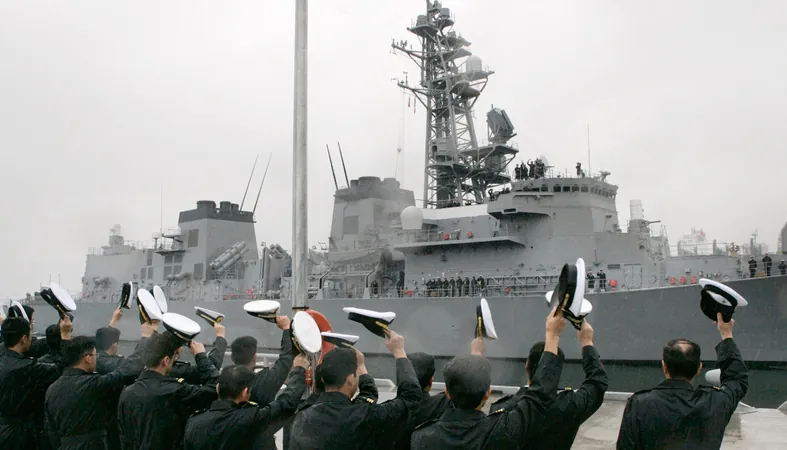
Japan Makes Bold Move: Warship Passes Through Taiwan Strait for the First Time!
2024-09-26
Author: Yan
Japan’s Groundbreaking Passage Through Taiwan Strait
In a groundbreaking development, Japan has sent a destroyer through the Taiwan Strait for the first time, amidst rising military tensions from China. The destroyer Sazanami entered the strait from the East China Sea early Wednesday morning, completing an extensive passage that lasted over ten hours, as reported by major Japanese media outlets such as NHK and the Yomiuri Shimbun.
A Joint Operation with Allies
This historic journey was part of a joint operation with naval vessels from Australia and New Zealand, ahead of planned military drills in the contested South China Sea. The collaboration underscores the strengthening ties between these nations as they navigate their shared concerns regarding China's assertiveness in regional waters.
China’s Response
Following this transit, the Chinese military expressed heightened vigilance, labeling Japan's military maneuvers as provocative. "China is highly vigilant about the political intentions of Japan’s actions," a spokesperson from China’s Ministry of Foreign Affairs stated, urging Japan to adhere to its commitments concerning Taiwan and avoid escalating tensions in the strait.
Japan’s Diplomatic Stance
Japan’s government has remained relatively tight-lipped on the matter. Yoshimasa Hayashi, Japan's top spokesperson, opted not to comment during a regular briefing, emphasizing that the issue pertained to military operations. Nevertheless, the Japanese Ministry of Defence has dealt with previous provocations, including incidents of Chinese aircraft entering Japanese airspace in recent months.
Recent Provocative Actions and Tensions
The safe passage of the Japanese destroyer coincided with a provocative display from China, as reports surfaced of the Chinese aircraft carrier Liaoning navigating between two islands near Japan. Tokyo condemned this action, deeming it "totally unacceptable," while China insisted it had acted in line with international law.
Growing Military Activity
The situation illustrates deepening tensions in the region. In August, a Chinese surveillance plane was reported to have breached Japanese airspace, escalating concerns from Tokyo. In reaction to this growing military activity, Prime Minister Fumio Kishida reportedly directed the Sazanami's transit to prevent further encouragement of Chinese assertiveness.
Global Concerns and Expert Insights
Japan’s anxieties are echoed by experts who review China's "grey zone" tactics—strategies aimed at wearing down a nation’s defenses without resorting to outright conflict. "Japan has been consistently tackling these grey-zone tactics in the East China Sea," noted international relations expert Bec Strating, emphasizing a larger trend of nations reinforcing their naval presence as a counterbalance to China’s maritime maneuvers.
China’s Military Tests
Further raising alarms, on the same day as Japan's naval operation, China conducted a test of an intercontinental ballistic missile into the Pacific Ocean, marking its first such testing in decades. Japan expressed "serious concern" after not receiving prior notification of this military exercise, adding fuel to the fire of apprehension regarding China's expanding military ambitions.
Strengthening Alliances
As tensions grow, the Quad nations—Australia, India, Japan, and the United States—are intensifying security measures in response to the situation. Their collaboration signifies a united front against the backdrop of escalating military activity in Asia's waters.
Taiwan’s Alert
Meanwhile, Taiwan remains on high alert, reporting a marked increase in Chinese military activity around the island, including joint operations involving numerous aircraft and warships. The Taiwanese Ministry of Defense recently detected 29 Chinese aircraft in coordinated patrols, further emphasizing the precarious balance of power in the region.
Conclusion: A New Chapter in Regional Security?
As Japan navigates this complex situation, its decision to assert its presence in the Taiwan Strait may signal a new chapter in regional security dynamics—a bold assertion amid rising tensions that echoes calls for a balanced approach to ensure peace and stability in the Asia-Pacific region. Will this action spark a broader military response from China? Only time will tell.

 Brasil (PT)
Brasil (PT)
 Canada (EN)
Canada (EN)
 Chile (ES)
Chile (ES)
 España (ES)
España (ES)
 France (FR)
France (FR)
 Hong Kong (EN)
Hong Kong (EN)
 Italia (IT)
Italia (IT)
 日本 (JA)
日本 (JA)
 Magyarország (HU)
Magyarország (HU)
 Norge (NO)
Norge (NO)
 Polska (PL)
Polska (PL)
 Schweiz (DE)
Schweiz (DE)
 Singapore (EN)
Singapore (EN)
 Sverige (SV)
Sverige (SV)
 Suomi (FI)
Suomi (FI)
 Türkiye (TR)
Türkiye (TR)